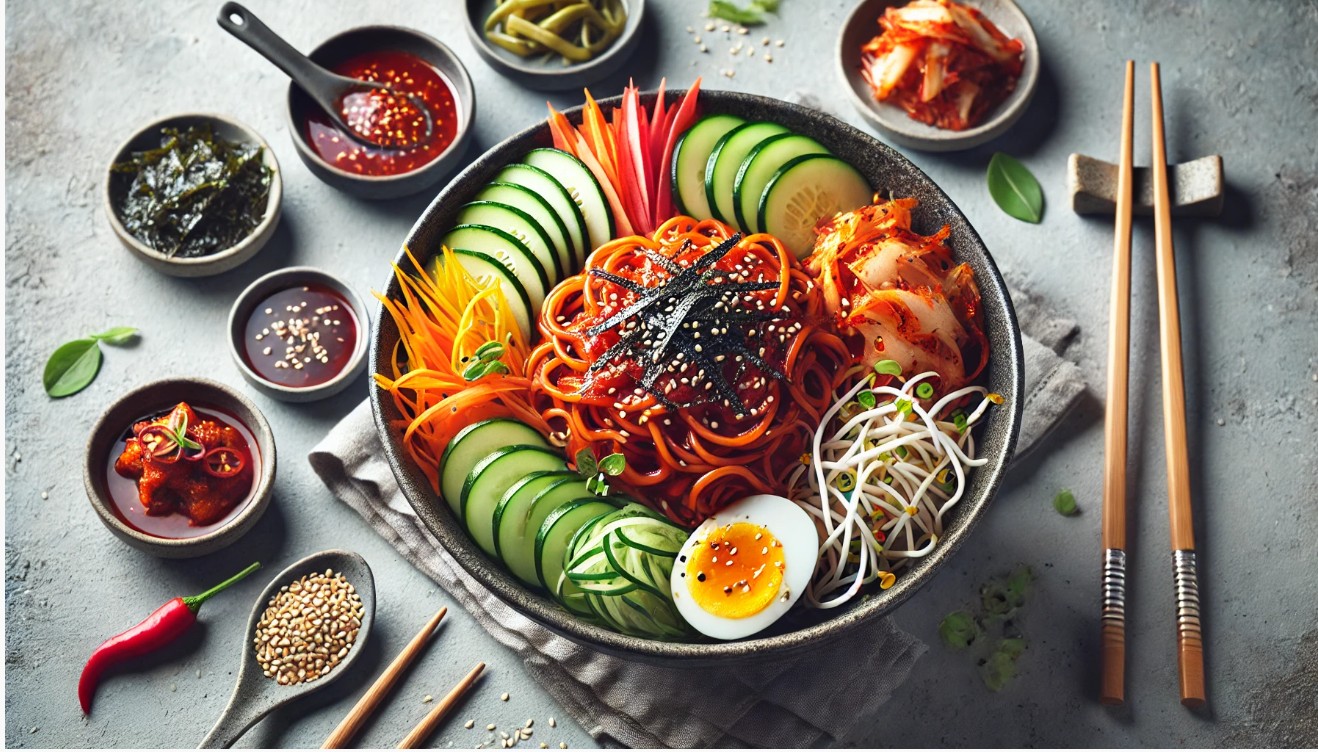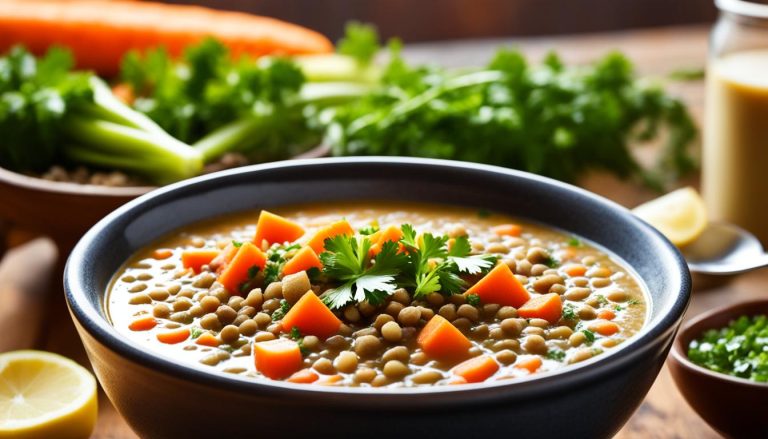Kal Bibimmyeon is a flavorful and refreshing Korean cold noodle dish that combines chewy wheat noodles with a tangy, spicy, and slightly sweet sauce.
The sauce, made from gochujang (Korean chili paste), soy sauce, sesame oil, rice vinegar, sugar, and honey, creates a well-balanced blend of heat, sweetness, and umami.
The noodles are topped with fresh, crisp vegetables like cucumber, carrots, and bean sprouts, adding texture and color. Additional toppings such as a hard-boiled egg, kimchi, nori (seaweed), and toasted sesame seeds bring extra layers of flavor, creating a satisfying and complex dish.
This dish is highly versatile, making it easy to customize to suit different dietary preferences. You can add grilled or pan-fried protein options such as bulgogi beef, pork belly, or chicken breast for a heartier meal.
For seafood lovers, shrimp, octopus, or squid can be added, while vegetarians can enjoy tofu or mushrooms as a substitute.
Kal Bibimmyeon recipe is quick to prepare and perfect for warm weather, offering a refreshing and filling meal that’s ideal for lunch, dinner, or even as a side dish for a Korean BBQ spread. Its simplicity, yet deep flavor profile, makes it a beloved dish in Korean cuisine.
Why Kal Bibimmyeon Recipe is Famous?
Kal Bibimmyeon is a standout Korean dish known for its bold flavors, refreshing ingredients, and versatility. This cold noodle dish, perfect for warm weather, features chewy wheat noodles coated in a tangy, spicy, and slightly sweet gochujang-based sauce.
Fresh vegetables like cucumber and bean sprouts add crisp texture, while toppings such as hard-boiled eggs, nori, and kimchi enhance richness and umami.
Its adaptability makes it even more popular, with options for vegetarians, seafood lovers, and meat enthusiasts alike.
Quick to prepare and customizable with various proteins and toppings, Kal Bibimmyeon is ideal as a main dish, light lunch, or a side for Korean BBQ, loved worldwide for its delicious and satisfying appeal.
Kal Bibimmyeon Recipe Ingredients
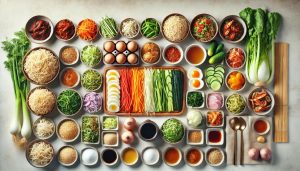
For the Noodles
| Quantity | Ingredient |
| 200g | Korean wheat noodles (Kal-guksu) or somyeon |
| As needed | Water for boiling noodles |
For the Sauce
| Quantity | Ingredient |
| 3 tablespoons | Gochujang (Korean red chili paste) |
| 1 tablespoon | Soy sauce |
| 1 tablespoon | Sesame oil |
| 1 tablespoon | Rice vinegar |
| 1 tablespoon | Sugar |
| 1 tablespoon | Honey or corn syrup |
| 2 teaspoons | Minced garlic |
| 1 teaspoon | Gochugaru (Korean red chili flakes) (optional) |
| To taste | Salt and pepper |
For the Toppings
| Quantity | Ingredient |
| 1/2 | Cucumber, julienned |
| 1/2 | Carrot, julienned |
| 1/2 | Onion, thinly sliced |
| 1 | Hard-boiled egg, halved |
| 1/4 cup | Kimchi, chopped |
| 1/4 cup | Blanched bean sprouts |
| 1 | Green onion, finely chopped |
| 1 sheet | Nori (seaweed), cut into thin strips |
| 1 tablespoon | Toasted sesame seeds |
Optional Add-ons
| Quantity | Ingredient |
| As needed | Sliced beef, pork, or chicken (grilled or pan-fried) |
| As desired | Extra vegetables like lettuce, radish, or spinach |
Kal Bibimmyeon Recipe Instructions
Step 1: Prepare the Noodles
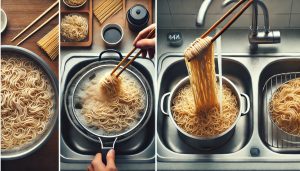
- Bring a large pot of water to a boil.
- Add the Kal-guksu or somyeon noodles and cook according to the package instructions (usually about 5-7 minutes for Kal-guksu or 3-4 minutes for somyeon).
- Stir the noodles occasionally to prevent them from sticking.
- Once cooked, drain the noodles and rinse them under cold water to stop the cooking process and chill them.
- Toss the noodles with a few drops of sesame oil to prevent sticking and set them aside.
Step 2: Make the Sauce

- In a mixing bowl, combine gochujang, soy sauce, sesame oil, rice vinegar, sugar, honey (or corn syrup), minced garlic, gochugaru, salt, and pepper.
- Mix well until smooth and well combined.
- Taste the sauce and adjust sweetness, tanginess, or spiciness as desired by adding more sugar, rice vinegar, or gochugaru.
Step 3: Prepare the Toppings
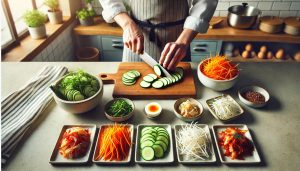
- Julienne the cucumber and carrot.
- Thinly slice the onion and soak it in cold water for 10 minutes to reduce the sharp flavor. Drain and set aside.
- Boil the egg for 8-10 minutes, then peel and slice it in half.
- Blanch the bean sprouts in boiling water for 1-2 minutes, then rinse with cold water and set aside.
- Chop the kimchi into small pieces.
- Cut the nori into thin strips.
Step 4: Assemble the Kal Bibimmyeon
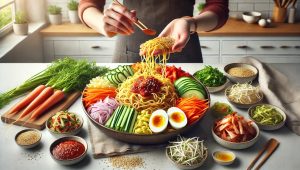
- Place the cold noodles in a large serving bowl.
- Pour the spicy sauce over the noodles.
- Arrange the toppings (cucumber, carrot, onion, egg, kimchi, bean sprouts, green onion, and nori) over the noodles.
- Sprinkle toasted sesame seeds on top for garnish.
- If using additional protein (like grilled beef, pork, or chicken), add it on top.
Step 5: Serve and Enjoy
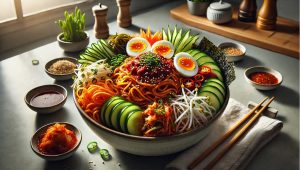
- Toss the noodles and toppings together just before eating to ensure everything is coated in the delicious sauce.
- Serve immediately as a refreshing main dish or light lunch.
- Enjoy the perfect balance of spicy, sweet, and tangy flavors in every bite.
Kal Bibimmyeon Recipe Variations
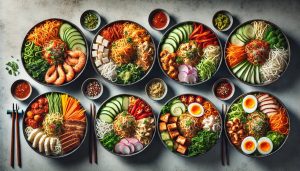
Classic Kal Bibimmyeon
Instructions:
- Prepare the Noodles: Cook 200g of Korean wheat noodles (Kal-guksu or somyeon) for 5-7 minutes (Kal-guksu) or 3-4 minutes (somyeon). Drain, rinse under cold water, and set aside.
- Make the Sauce: Combine 3 tbsp gochujang, 1 tbsp soy sauce, 1 tbsp sesame oil, 1 tbsp rice vinegar, 1 tbsp sugar, 1 tbsp honey, 2 tsp minced garlic, 1 tsp gochugaru (optional), salt, and pepper. Mix well.
- Prepare the Toppings: Julienne 1/2 cucumber, 1/2 carrot, and 1/2 onion. Boil 1 egg for 8-10 minutes, peel, and slice. Blanch 1/4 cup bean sprouts, chop 1/4 cup kimchi, and cut 1 sheet nori into strips.
- Assemble: Place noodles in a bowl, pour sauce over, and arrange toppings on top. Sprinkle with toasted sesame seeds and green onion.
- Serve: Toss just before eating. Serve immediately.
Difference: Classic Kal Bibimmyeon features fresh vegetables, chewy noodles, and a spicy-sweet sauce, offering a traditional, refreshing, and vibrant dish.
Seafood Kal Bibimmyeon
Instructions:
- Prepare the Noodles: Cook noodles as in the classic recipe, rinse, and set aside.
- Make the Sauce: Prepare the same spicy-sweet sauce.
- Prepare the Seafood: Lightly boil or pan-sear 150g shrimp, octopus, or squid for 2-3 minutes.
- Assemble: Add seafood to the noodles with the sauce, vegetables, and garnishes as in the classic recipe.
- Serve: Toss and serve.
Difference: Seafood Kal Bibimmyeon adds shrimp, octopus, or squid, creating an ocean-inspired twist with fresh, briny flavors complementing the spicy noodles.
Vegetarian Kal Bibimmyeon
Instructions:
- Prepare the Noodles: Cook noodles as in the classic recipe, rinse, and set aside.
- Make the Sauce: Prepare the same spicy-sweet sauce.
- Prepare the Toppings: Use tofu (pan-fried), mushrooms, bell peppers, and radishes instead of meat or seafood.
- Assemble: Add tofu and vegetables to the noodles with the sauce and garnishes.
- Serve: Toss and serve.
Difference: Vegetarian Kal Bibimmyeon replaces meat and seafood with tofu, mushrooms, and vegetables, offering a plant-based, wholesome alternative.
Spicy Kal Bibimmyeon
Instructions:
- Prepare the Noodles: Cook noodles as in the classic recipe, rinse, and set aside.
- Make the Sauce: Add extra gochugaru and chili oil to the classic sauce for extra heat.
- Prepare the Toppings: Follow the classic recipe for vegetables and garnishes.
- Assemble: Pour the extra-spicy sauce over the noodles with toppings.
- Serve: Toss and serve.
Difference: Spicy Kal Bibimmyeon increases the heat with extra chili flakes and chili oil, making it a fiery version for spice lovers.
Meat Lover’s Kal Bibimmyeon
Instructions:
- Prepare the Noodles: Cook noodles as in the classic recipe, rinse, and set aside.
- Make the Sauce: Prepare the same spicy-sweet sauce.
- Prepare the Meat: Grill or pan-fry 150g bulgogi beef, pork belly, or chicken breast, and slice.
- Assemble: Add meat on top of noodles with sauce and toppings.
- Serve: Toss and serve.
Difference: Meat Lover’s Kal Bibimmyeon adds bulgogi beef, pork belly, or chicken for a protein-packed, savory version that’s heartier than the classic.
Kal Bibimmyeon Recipe Serving Suggestions
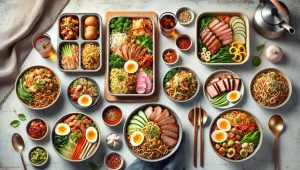
- As a Main Course: Kal Bibimmyeon is a complete, hearty dish with chewy noodles, tangy sauce, and fresh toppings. Add grilled meat, tofu, or seafood for a balanced meal, perfect for lunch or dinner.
- As a Side Dish: Pair Kal Bibimmyeon with Korean BBQ meats like bulgogi or galbi. The refreshing, tangy noodles balance the rich, smoky flavors of grilled dishes, offering a harmonious dining experience.
- As a Light Lunch: Enjoy Kal Bibimmyeon as a quick and healthy lunch. Serve with fresh vegetables and optional protein like tofu or eggs for a light yet filling midday meal.
- As a Meal Prep Option: Prepare Kal Bibimmyeon components in advance—store noodles, sauce, and toppings separately. Assemble when needed for a quick, flavorful, and nutritious meal throughout the week.
Kal Bibimmyeon Recipe Nutrition Details
| Nutrient | Amount per Serving |
| Calories | 480 |
| Protein | 15g |
| Carbohydrates | 68g |
| Fat | 12g |
| Fibre | 5g |
| Sodium | 920mg |
Note: Nutritional values may vary based on ingredient brands, portion sizes, and optional add-ons like meat or seafood.
Conclusion
Kal Bibimmyeon is a delicious and versatile dish that’s perfect for hot summer days or any time you crave a refreshing yet satisfying meal.
With its chewy noodles, fresh vegetables, spicy-sweet sauce, and customizable toppings, you’ll be able to create a restaurant-quality Korean dish at home.
Whether you stick to the classic recipe or try one of the flavorful variations, Kal Bibimmyeon is sure to become a favorite in your meal rotation. Happy cooking!
Kal Bibimmyeon Recipe FAQs
What is Kal Bibimmyeon?
Kal Bibimmyeon is a Korean cold noodle dish made with chewy wheat noodles, a tangy, spicy, and slightly sweet gochujang-based sauce, and a variety of fresh vegetables and toppings like cucumbers, carrots, and a hard-boiled egg. It’s a refreshing, customizable meal often enjoyed during warm weather.
Can I adjust the spice level?
Yes, you can adjust the spice level by adding more or less gochugaru (Korean red chili flakes) or gochujang (Korean chili paste). For extra heat, you can also drizzle chili oil or add fresh chili peppers to the sauce.
What protein options can I use?
Kal Bibimmyeon can be made with a variety of proteins. You can add grilled or pan-fried meats like bulgogi beef, pork belly, or chicken breast, or opt for seafood such as shrimp, squid, or octopus. Vegetarians can enjoy tofu, mushrooms, or other vegetables.
Can I make Kal Bibimmyeon ahead of time?
Yes! You can prepare the components ahead of time—cook the noodles, make the sauce, and chop the toppings. Store them separately and assemble the dish just before serving. This makes it a great option for meal prep.
What should I serve with Kal Bibimmyeon?
Kal Bibimmyeon can be served as a main dish, side dish, or light lunch. It pairs wonderfully with Korean BBQ, such as bulgogi or galbi, and can also be enjoyed on its own for a refreshing meal.
How can I customize Kal Bibimmyeon?
Kal Bibimmyeon is highly customizable. You can add your favorite vegetables, choose different protein options, or even make it spicier or milder. For a unique twist, try adding seafood, grilled meats, or additional vegetables like spinach or radishes.
Is Kal Bibimmyeon a healthy dish?
Yes, Kal Bibimmyeon can be a healthy dish, especially if you use fresh vegetables, lean proteins, and moderate amounts of sauce. It offers a good balance of carbohydrates, protein, and fiber, making it a satisfying and nutritious meal.
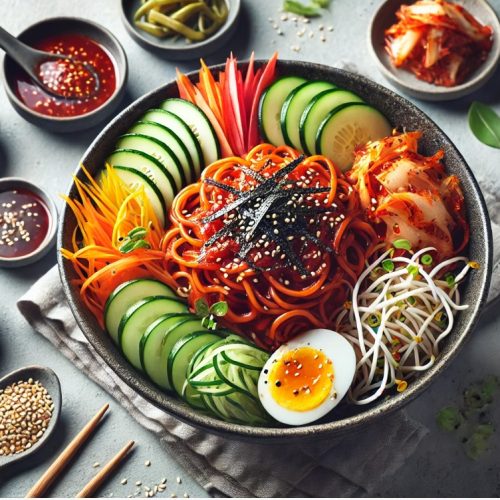
Kal Bibimmyeon Recipe
Ingredients
- 200 g Korean wheat noodles Kal-guksu or somyeon
- As needed Water for boiling noodles
- 3 tablespoons Gochujang Korean red chili paste
- 1 tablespoon Soy sauce
- 1 tablespoon Sesame oil
- 1 tablespoon Rice vinegar
- 1 tablespoon Sugar
- 1 tablespoon Honey or corn syrup
- 2 teaspoons Minced garlic
- 1 teaspoon Gochugaru Korean red chili flakes (optional)
- To taste Salt and pepper
- 1/2 Cucumber julienned
- 1/2 Carrot julienned
- 1/2 Onion thinly sliced
- 1 Hard-boiled egg halved
- 1/4 cup Kimchi chopped
- 1/4 cup Blanched bean sprouts
- 1 Green onion finely chopped
- 1 sheet Nori seaweed, cut into thin strips
- 1 tablespoon Toasted sesame seeds
- As needed Sliced beef pork, or chicken (grilled or pan-fried)
- As desired Extra vegetables like lettuce radish, or spinach
Instructions
- Bring a large pot of water to a boil.
- Add the Kal-guksu or somyeon noodles and cook according to the package instructions (usually about 5-7 minutes for Kal-guksu or 3-4 minutes for somyeon).
- Stir the noodles occasionally to prevent them from sticking.
- Once cooked, drain the noodles and rinse them under cold water to stop the cooking process and chill them.
- Toss the noodles with a few drops of sesame oil to prevent sticking and set them aside.
- In a mixing bowl, combine gochujang, soy sauce, sesame oil, rice vinegar, sugar, honey (or corn syrup), minced garlic, gochugaru, salt, and pepper.
- Mix well until smooth and well combined.
- Taste the sauce and adjust sweetness, tanginess, or spiciness as desired by adding more sugar, rice vinegar, or gochugaru.
- Julienne the cucumber and carrot.
- Thinly slice the onion and soak it in cold water for 10 minutes to reduce the sharp flavor. Drain and set aside.
- Boil the egg for 8-10 minutes, then peel and slice it in half.
- Blanch the bean sprouts in boiling water for 1-2 minutes, then rinse with cold water and set aside.
- Chop the kimchi into small pieces.
- Cut the nori into thin strips.
- Place the cold noodles in a large serving bowl.
- Pour the spicy sauce over the noodles.
- Arrange the toppings (cucumber, carrot, onion, egg, kimchi, bean sprouts, green onion, and nori) over the noodles.
- Sprinkle toasted sesame seeds on top for garnish.
- If using additional protein (like grilled beef, pork, or chicken), add it on top.
- Toss the noodles and toppings together just before eating to ensure everything is coated in the delicious sauce.
- Serve immediately as a refreshing main dish or light lunch.
- Enjoy the perfect balance of spicy, sweet, and tangy flavors in every bite.


